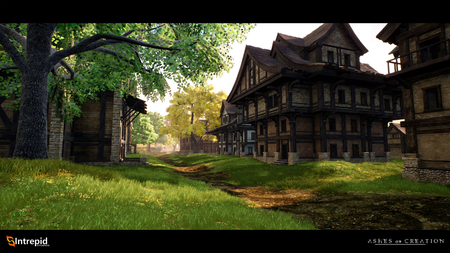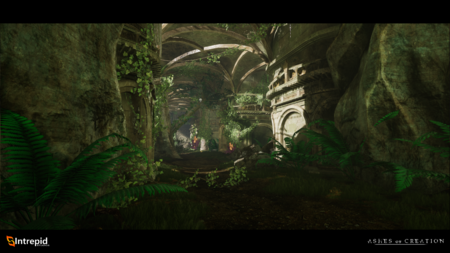Entwicklung der Node
Alle Aktivitäten (Aufträge, Sammeln, Schlachtzüge, etc.) welche von Bürgern sowie allen anderen Spielern innerhalb des Einflussbereichs einer Node ausgeführt werden, tragen zum Wachstum (Fortschritt) dieser speziellen Node bei.[1][2]
Durch das Wachstum einer Node werden einerseits deren einzigartigen Inhalte freigeschaltet, andererseits wird der Fortschritt der umliegenden Nodes auf die nächste Stufe blockiert.[3]
- Nodes steigen schnell auf die erste Stufe auf. Dadurch entstehen die ersten NPC-Dienstleistungen, beispielsweise der Verkauf oder die Aufbewahrung von items.[4]
- Je fortgeschritttener die Node ist, desto größer ist ihr ZOI.[5]
- Weniger weit fortgeschrittene Nodes (auch Vasallen-Nodes genannt), welche im Einflussbereich einer höherstufigen Node liegen, können weiterhin Erfahrung sammeln, jedoch müssen sie stets mindestens eine Stufe unter der ihrer übergeordneten Node bleiben.[6]
- Das Vasallen-System tritt erst ab Node-Stufe 3 (Dorf) in Effekt, jedoch blockieren Nodes bereits ab Node-Stufe 1 (Expedition) das Wachstum ihrer direkten Nachbarn.[7][8]
- Der Algorithmus zur Gebietserweiterung berücksichtigt nahegelegene Küsten, benachbarte Nodes, und die am häufigsten Besuchten Orte von Spielern innerhalb der letzten Woche, bzw. des letzten Monats.[9]
- Aufgrund der Art und Weise, wie dieser Algorithmus den neuen Einflussbereich während des Aufstiegs berechnet, kann es vorkommen, dass zwei Nodes mit der gleichen Node-Stufe nah beieinander liegen.[10]
Die Art und Weise, wie der Algorithmus die Gebiete erweitert, berücksichtigt einige Dinge: Erstens berücksichtigt er die Küste, beispielsweise wo die nächstgelegene Küste ist. Zweitens berücksichtigt es die benachbarten Modepunkte, sodass es diese Nodepunkte übernehmen und im Wesentlichen zu Vasallen machen kann. Wichtiger ist jedoch im Wesentlichen die anfängliche Bevölkerung, die darauf basiert, wie die Spieler ihre Rassen auswählen. Da wir neun verschiedene Rassen und vier verschiedene Startpunkte haben, die sich verzweigen, bestimmt die Bevölkerungsdichte jedes Servers im Wesentlichen die ersten paar Knoten, die stark bevölkert sind, und dieser anfängliche Samen bestimmt dann die Knotenstruktur, wenn er landeinwärts wandert das in die Welt im Wesentlichen; und basierend auf der Leistung und den Erfolgen verschiedener Belagerungen wird bestimmt, welche Node, die von den vorherigen anfänglichen Weiterentwicklungen ausgeschlossen wurden, welche Node jetzt für weitere Fortschritte verfügbar sind. Ich glaube also wirklich, dass bei so vielen Variablen, die in der Gleichung dafür vorhanden sind, wie Nodes voranschreiten und bestehen bleiben, die Wahrscheinlichkeit umso höher ist, dass es zu einer erheblichen Abweichung im Weltfortschritt kommt, je mehr Variablen man hat.[9] – Steven Sharif
Normalerweise verhindert der Algorithmus, der auf die territoriale Erweiterung der Node angewendet wird, dass wichtige Knoten nahe beieinander liegen Es gibt bestimmte Anforderungen, die verfügbar sein müssen, um Nodevasallenübernahmen zu erfüllen. Und es ist möglich, dass zwei Nodes sich niemals gegenseitig als Vasallen übernehmen und am Ende nahe beieinander liegen und ihre Territorien in entgegengesetzte Richtungen umspannen: Die Sache mit der Geschichte zweier Städte.[10] – Steven Sharif
- Vasallen-Nodes geben überschüssige Erfahrungspunkte erst dann an ihre übergeordnete Node weiter, wenn sie ihre Level-Grenze erreicht haben..[6]
- Die Möglichkeiten, für eine Node Erfahrungspunkte zu sammeln, sind für alle Arten von Nodes gleich.[12]
- Um Manipulation zu vermeiden, ist die exakte Anzahl an hinzugefügten Erfahrungspunkten für die Node durch das Erhalten von Gegenstände oder dem Töten von Gegnern nicht bekannt.[13]
Verschiedene Leute investieren unterschiedliche Ressourcen in die Weiterentwicklung von Nodes, und es wäre ein wenig „spielerisch“, wenn man genau wissen könnte, was zu diesem Zeitpunkt notwendig ist, denn das würde die Leute von der Teilnahme abhalten.[13] – Steven Sharif
Verschiedene Animationen und visuelle Effekte innerhalb der Grundfläche einer Node leiten den Beginn des ihres Aufstiegs ein.[14][1]
- Spieler, die sich zu diesem Zeitpunkt innerhalb der Node befinden, werden zu einem sicheren Ort teleportiert (beispielsweise einem Spawn-Punkt).[14][15]
- Um die Node herum spawnen Materialien, welche von systemgesteuerten Karawanen in die Node transportiert werden. Diese Karawanen können nicht angegriffen werden.[14]
- NPCs beginnen mit den Bauarbeiten.[14]
- Spieler, welche sich außerhalb der Node befinden, können die stufenweise visuelle Transformation der Node beobachten.[14]
Das Entwicklungsgebiet eines Nodepunktes ist der Ort, an dem die Zivilisation erscheint, wenn der Knotenpunkt voranschreitet. Mit zunehmender Nodestufe werden im Entwicklungsbereich verschiedene Gebäude, NPCs und Dienste verfügbar. Je höher die Nodestufe, desto komplexer und bevölkerter wird das Entwicklungsgebiet. Entwicklungsgebiete variieren auch je nach Knotentyp – wirtschaftlich, militärisch, wissenschaftlich oder göttlich.[1] – Margaret Krohn
Node-Stufen
Nodes advance by collecting experience from the actions of players nearby. As players complete content inside of a Node’s Zone of Influence (the area around the node), they contribute that experience toward the Node’s development. The experience given to the Node may then be modified based on certain Events and Accomplishments. When a Node reaches the experience required, it undergoes the process of advancing to the next stage. There are a few exceptions where a Node cannot advance even though it has the required experience - most commonly, a Node can not advance if a Node is a Vassal of another Node and would advance to the same stage as its Parent Node.[1] – Margaret Krohn
Nodes haben sieben (7) Entwicklungsstufen, mit Erfahrungsschwellen für jede Stufe. Sobald eine Node die benötigte Erfahrung (XP) für die aktuelle Stufe angesammelt hat, steigt sie zu der nächsten Stufe auf.[16]
| Node-Stufe.[2] | Symbol | Alternativer Name.[17] | Benötigte Zeit für den Aufstieg.[2] | Spielerbehausungen.[18] | |
|---|---|---|---|---|---|
| 0. | Wildnis | - | |||
| 1. | Expedition | Kreuzung | Wenige Stunden | - | |
| 2. | Feldlager | Lager | Viele Stunden | - | |
| 3. | Dorf | - | Wenige Tage | Kleine Häuser | |
| 4. | Stadt | - | Viele Tage | Mittelgroße Häuser | |
| 5. | Großstadt | - | Wenige Wochen | Große Häuser | |
| 6. | Metropole | Metro | Viele Wochen | Villen |
Vasallen-Nodes
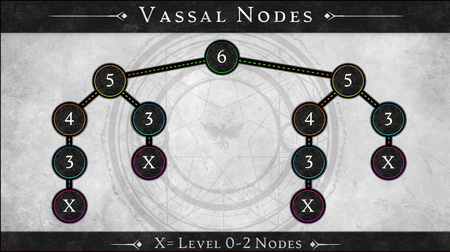
This vassal mode structure tells you what it looks like for a sovereign at a level six metropolis stage; and what it can control at a maximum vassal network is two level five nodes, of which a level five node can control one level four and one level three as direct vassals; and then the four can control a three; and every three can control a one or a two. Now if the three gets removed through siege, the one or the two is removed as well. So that's an important distinction between the three's vassals, which technically isn't really a vassal relationship because there's no citizenships possible. Those vassals don't exist between three and X, but they do exist between four and three, five and four, and six and five. And what this also allows is that because there are 85 nodes that are within the world, we have a buffer zone of about 20 nodes that lives in a max server state. So if you had maximum five metropolises form in a world, you will have a number about 20 nodes that can live alongside those metropolis networks; and when or if a metropolis falls, that extra cushion of nodes around the five metropolis structures allows for the map to be redistricted in a way that is unique. It doesn't mean that one of the fives is just going to pick up where the last six left off and form the same exact metropolis structure. From a territory perspective it has ancillary nodes to play with and expand towards that redistricts the map, so that if a metropolis falls there's a significant difference in the layout of the world and the layout of these almost nation-like territories.[19] – Steven Sharif
Village (stage 3) or higher nodes enslave nearby nodes, converting them into vassal nodes.[16][8]
- A Metropole (Stufe 6) can control up to two Großstadt (Stufe 5) nodes. A Großstadt (Stufe 5) can control one Stadt (Stufe 4) and one Dorf (Stufe 3) node. A Dorf (Stufe 3) can control an Feldlager (Stufe 2) or an Expedition (Stufe 1). If the Dorf (Stufe 3) gets destroyed through a siege, its dependant Feldlager (Stufe 2) and Expedition (Stufe 1) nodes are also destroyed.[19]
- There is a layer of intricacy between how the neighboring nodes advance and what potential parent structure they have in the vassalship tree.[20] – Steven Sharif
- Vassal nodes gain benefits from their regent node (also referred to as sovereign node or parent node) even if the node type of the parent is different to the vassal.[21][22]
- It is not a bad thing to be vasseled, it is a good thing to be vasseled. It brings many benefits from the Sovereign, which is the ultimate parent of that vassal network down to the vassal node itself; and it allows that vassal node to even live outside of its normal mechanics. You get to adopt some of the benefits that the node type of your sovereign is, even if your node type as a vassal node isn't the same.[22] – Steven Sharif
- Regent nodes collect taxes from their vassal nodes. These taxes cannot be taken by the mayor or other players.[24]
- Vassal nodes must remain at least one node stage below their parent node.[16]
- Neighboring/Adjacent nodes from Expedition (Stufe 1) upward block the growth of their immediate neighbors. This was intended to be tested in Alpha-1.[7][8]
- Vassal nodes first apply any experience earned to their own deficit (see Atrophie des Knotenpunkts). It then applies excess experience earned to its parent node.[1]
- If the parent node advances, the vassal is once again able to advance.[16]
- Vassal nodes give excess experience to their parent node and may have their own vassals; so long as they fall within the parent node’s zone of influence.[24][16]
- If a node is capped and is both a vassal and has its own vassals, any experience earned from itself or its Vassals is first applied to its own deficit. Experience beyond that is then sent to its parent node.[1]
- When the vassal reaches its cap it overflows experience up to the parent; and so it can be very good early on for parents to get vassal nodes that are very productive- that have a lot of traffic.[24] – Steven Sharif
- Vassals are subject to the government, alliances, wars, taxes, and trade of their parent node, and are able to receive federal aid from them.[16]
- Vassal nodes cannot declare war on their parent node or any of their vassals.[16]
- Citizens of vassals are bound by the diplomatic states of the parent node.[16]
- If a Node is a Vassal Node and is capped from advancing further, it first applies any experience earned to its own deficit (see Node Atrophy section), and then applies excess experience earned to its Parent Node. If the Parent Node advances and the Vassal is able to grow, it becomes uncapped. If a Node is capped and is both a Vassal and has its own Vassals, any experience earned from itself or its Vassals is first applied to their own deficit. Any experience beyond that is then sent to its Parent Node.[1] – Margaret Krohn
Adjacent/Neighboring nodes
Angrenzende Nodes (Nachbar-Nodes) blockieren ab Node Stufe 1 (Expedition) das Wachstum ihrer direkten Nachbarn .[7][8]
- Hierzu sind Tests während der Alpha-1 geplant.[7][8]
- Vasallen-Nodes müssen immer mindestens eine Node-Stufe unter ihrer übergeordneten Node bleiben.[16]
Zonen und Entwicklung
Dungeon, Schlachtzüge, Weltbosse, Mobs, Aufträge, Events, Ressorcen, Storys und andere Inhalte innerhalb der ZOI einer Node haben eine unterschiedliche Level-Reihe; wird aber mit det Weiterentwicklung dieser Node und seinem rassischen Einfluss skalieren.[25][26][16]
- Teile der Spawn-Tabellen (für Mobs und Ressourcen) sind statisch und andere Teile sind dynamisch und passen sich der Knotenentwicklung an. [27]
- Wir haben keine reine Level-25-Zone. Stattdessen könnte es in dieser Zone einige Kreaturen der Stufe 10 in der Nähe der Straße, einige Kreaturen der Stufe 20 tief im Wald und einige Kreaturen der Stufe 30 oben auf dem Berg geben. Diese Verhältnisse ändern sich abhängig von der Node, die euch informieren, und werden im Allgemeinen gefährlicher, wenn die Node wächst. Diese ganze Zivilisation zieht die Aufmerksamkeit von Dingen auf sich, die nicht sein sollten. Dies bedeutet keineswegs, dass Wildnisgebiete sicher sind. Einige mögen sicherer sein, aber alle bergen Gefahren, vor denen selbst der erfahrenste Reisende auf der Hut sein muss.[28] – Steven Sharif
Node simulation
This representation does show 111 nodes as part of this particular simulation. I'm not sure what the tick frequency is on this video. It might be something on the magnitude of like every second is probably 12 to 24 hours. So over time you start seeing these larger node systems building up to eventually where you might see Cities and Metropolises after some period of time; and what this allows the design team to do from a tools perspective, as they simulate this idea of how the world is going to progress, is it gives an opportunity to see strange happenings or something that we couldn't necessarily predict but was a possible outcome based on the variables present.[29] – Steven Sharif
The developers have created a simulation of node interactions in preparation for Alpha-2 deployment of the node system.[29]
- This simulates how nodes advance and expand their zones of influence over surrounding nodes.[29]
You can show the initial territories on the Verran map of what these particular nodes have governance over, or their Zones of Influence as we like to call them... As the simulation of this begins to advance and nodes begin to expand their territory and they begin to take over nearby nodes as a result of their of their growth, you start to see these power level ratings that are applied here on specific nodes that determines what type of takeover power it has and and what it pushes back against for other nodes that are looking to take over new territory as they advance.[29] – Steven Sharif
- It also simulates events, such as NPCs attacking and disabling certain node buildings and services. Failure to successfully respond to these will reduce the node's "health ticker", which will slow down the XP gains from the node.[29]
It also simulates events: So each of these nodes will have a health ticker: when that health ticker is impacted it'll stop gaining power or gaining or slow down in its gaining of experience; and that's because certain events can affect a node by disabling certain services, disabling buildings. Players don't respond to that horde of zombies that have come out of the nearby ravine then those zombies can attack stables, they can attack service buildings, and prevent particular types of quests or activities and services from happening until it's repaired.[29] – Steven Sharif
- Node-Belagerungen are simulated, with successful sieges destroying the nodes, and where unsuccessful sieges won't destroy the node but may result in disabled buildings or services, similar to events.[29]
It simulates the sieges if a particular node has a certain frequency that's set where we want to see randomization of how nodes get affected by sieges. Sometimes they'll be destroyed in the simulation. Sometimes they'll have disabled services again, similar to an event, because they didn't succeed necessarily at sieging the node but they did succeed at disabling some of the buildings as part of that siege.[29] – Steven Sharif
- It simulates what outcomes may happen in the live game as a result of player activity, such as splitting up a particular ZOI across a waterway, or having territories expand out to islands or across continents.[29]
It simulates what players could potentially do as well when the game goes live; and that might include things like splitting up a particular Zone of Influence across a waterway, having your territory expand out to an island, or across continents. These are these are the types of things that we want to see players do eventually obviously but this tool provides the design team the opportunity to see it repetitively and over a fast period of time so they see these different types of outcomes.[29] – Steven Sharif
World manager
The World manager is an algorithm in Ashes of Creation that controls dynamic world elements. It acts as both a throttle and an incentive system for various activities to ensure certain parameters are within acceptable thresholds.[30]
- A world manager is a technical term to define a server process that lives alongside the game server; and when the game server needs to do things- communicating with other game servers within that grid- it tells that manager and that manager sends it down to the appropriate server.[31] – Steven Sharif
- Prices of glint.[32]
- A heatmap of experience being gained to apply to node advancement.[32]
- The territory expansion algorithm takes into account the nearest coast, neighboring nodes, and the heatmap of players in surrounding areas over the last weeks or month.[9]
- Due to the way the progression algorithm calculates territorial (ZOI) expansion during node advancement, there is a small possibility that two nodes of the same stage end up being close to each other.[10]
- Transit of resources and goods between regions to drive quest rewards for nodes.[32]
- For example if you know iron is being used as a raw resource for a specific crafting path that might drive up the price of mithril or silver; and that will incentivize the market to course correct a little bit. The idea is to provide soft incentives that help to alleviate the demand and also to prop up the supply that might not be present from the economic systems.[32] – Steven Sharif
Bevölkerungsbasierte Skalierung
The prices that NPCs sell items for will scale based on the economic activity on a server. Prices will rise to combat inflation and fall as a population diminishes.[33]
The node system allows the developers to scale the experience needed to level a node and the attrition that affects a node based on activity.[33]
Things that NPCs buy and sell scale based on the economic activity that exists on that server... As inflation rises, prices rise and everything ends up being equal, even though there might be a couple of extra zeros. So that can go up and it can also go down so as a population leaves, things become less expensive and players don't have to do as much to earn that. On the other side of things we look at the node system and the node system is set up in this really flexible way that allows us to scale the experience needed to level a node and the attrition that delevels a node to scale based on activity too. So it's just a matter of adjusting a couple of constants and that goes up and down and the server can watch it and change those on the fly as it needs to.[33] – Jeffrey Bard
Beute-Tabellen
- Mobs drop glint, Gegenstände, and crafting materials in preference to gold.[35][36]
- Glint is not bound to a specific region and can be also dropped by players on death as stolen glint, based on applicable death penalties.[37][38][39][40][35][41]
- The rarity of glint increases with the mob's level.[42]
- Loot tables are disabled for player controlled monsters.[43]
- There is a small RNG chance of looting rare and legendary items or crafting materials from mobs based on the level, status and type of mob. This also applies to harvesting resources with a gathering profession.[44]
- Experience debt decreases the drop rate percentages from monsters.[45]
- Loot (loot tables) from world bosses or dungeon bosses has a small RNG chance of dropping gear (completed items).[46][47]
- There is a much higher chance that materials and unique recipes are dropped that can be used to craft items of equitable value.[46][48][49]
- Legendary equipment is only dropped by Legendary world bosses.[50]
- Loot tables will likely not be affected by weather conditions.[52] This was previously listed as a possible effect.[53]
- There won't be specific loot drops for artisans.[54] Previously it was stated that master gatherers may have the ability to "spoil" a boss' loot.[55]
- Q: Can only one gathering artisan harvest resources from a single boss, or can multiple different artisans harvest different parts from a boss for different resources? For example, a lumberjack gets a special wood from Tumock's tree weapon, while a herbalist gathers the flowers from that same tree.
- A: We don't have the concept of harvesting from bosses. NPCs follow a reward table format, where those reward tables are global. They're not unique to particular players. So, once the NPC is vanquished, you have access to the loot container that is its corpse; and it has a static value of either materials or items that get dropped; and whatever the party loot settings are that you might be a part of, or if you're a solo player you will be able to recover those things.[54]
Nodes

Nodes sind ein voreingestellter Ort in unserer Welt, der in einer Einflusszone liegt und Städte unterschiedlicher Größe bilden kann. Diese Größen reichen von einem kleinen Lager bis zu einer weitläufigen Metropole. Die Größe der Städte hängt vom Beitrag der Spieler und davon ab, wie weit sie den Nodepunkt fortgeschritten sind. Spieler erstellen nicht den Fußabdruck einer Node, aber innerhalb dieses Fußabdrucks haben sie die Möglichkeit, Land zu besitzen. Spieler, die Teil der Regierung eines bestimmten Knotenpunkts sind, haben die Möglichkeit, Gebäudetypen und Dienstleistungen weiter zu modifizieren, aber zum größten Teil wächst ein Knotenpunkt entlang seines eigenen, spezifischen Pfades (stellen Sie sich das eher als NPCs vor, die diese Städte errichten, anstatt dass PCs einzeln Gebäude und Mauern errichten). Der Beitragsbereich eines Knotens ist größer als die eigentliche Stadt selbst, sodass Spieler Abenteuer erleben können, während sie auf der Stadt aufbauen. Wir nennen den Beitragsbereich die „Einflusszone“ der Node und es ist der Bereich, in dem Spieler helfen, der Node, in dem sie sich befinden, voranzubringen. [56]
Auf jedem Server befindet sich eine Vielzahl an Entwicklungspunkten, welche Nodes genannt werden.[2] Zum Launch wird es 85 normale Node-Standorte geben, zuzüglich 15 weiterer Burgen-Nodes (5 Burgen x je 3 Burgen-Nodes)[57][58][59], was insgesamt 100 Nodes ergibt.[60]
- Zuvor war von 103 Node-Standorten die Rede, zuzüglich 15 Burgen-Nodes, was insgesamt 118 Nodes entspricht.[16][61][57][58][59]
- Die Reduzierung der verfügbaren Nodes wird keinen Einfluss auf die Menge der verfügbaren Spielerbehausungen, oder die angestrebte Serverkapazität haben.[62][63]
- Wir sind von 103 Nodes auf 85 Nodes umgestiegen; Und dafür gibt es einige Gründe. Erstens: Als wir die Berechnungen anstellten, wie diese Vasallenstrukturen in Alpha 2 und im Spiel existieren sollen, hatten wir mehr Nodes, als uns sinnvoll erschienen, und wir wollten einige dieser kuratierten Handlungsstränge und -haken zu einer Zusammenfassung zusammenfassen Die Umgebung und das Reich um die Gebiete herum sollen bei einem geringeren Nodes üppiger sein: Das bedeutet, dass wir die Anzahl der Nodes verringern, damit wir den Reichtum jedes dieser Nodes mehr als bei 103 erhöhen können.[60] – Steven Sharif
- In der Alpha-1 gab es 9 Node-Standorte.[64]
- Node-Standorte können sich bis zur Beta-1 ändern.[64]
Nodes sind das Herz der Welt, sie schaffen das Auf und Ab des Lebens. Im Kern sind Nodepunkte voreingestellte Punkte auf der Welt, die von einer Einflusszone umgeben und von geografischen Gebieten umgeben sind, die sich im Laufe der Zeit je nach Spielerbeteiligung ändern. Die Weltkarte ist in Regionen unterteilt, wobei jede Region mehrere Nodes enthält. Wenn eine Node voranschreitet, beeinflusst er die Art der Inhalte in sich selbst und in den umliegenden Bereichen. Spieler erstellen keine Nodes, aber wenn sie Teil der Regierung einer bestimmten Node sind, haben sie die Möglichkeit, die Diplomatie zu beeinflussen und Gebäudetypen/Konstruktionen und Dienstleistungen innerhalb dieser Node zu ändern. [16] – Margaret Krohn
Atrophie des Knotenpunkts
Nodes accumulate an experience deficit each day based on the node's level, called node atrophy. The deficit is subtracted from any experience earned that day. If any deficit remains, then this is subtracted from the node’s experience pool.[1]
- An atrophy system may be implemented, where accumulated atrophy points will progressively disable services within a node. The node may be destroyed if a significant points threshold is reached.[10]
- There are intrinsic problems with reducing a nodes level as opposed to removing the node and it may be possible I'm just gonna say now that we don't actually atrophy nodes to delevel but rather accrue atrophy points that must be replenished over time; and if not it begins to disable services and further compound the atrophy problem; at which point when it reaches a certain atrophy point then the node would just disappear.[10] – Steven Sharif
Node layout and style
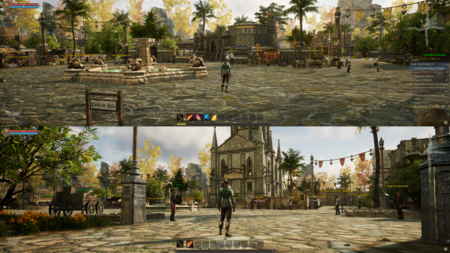
Das Layout und die Architektur innerhalb des Siedlungsgebiets einer Node werden durch die einflussreichste Volk bestimmt. Eine Node der Stufe 3, bei dem die Mehrheit der Spieler Py'rai sind, wäre zum Beispiel ein Py'rai-Dorf mit Py'rai-Architektur. Die meisten NSCs wären Py'rai-Elfen und würden Questlinien innerhalb der Py'rai-Erzählung anbieten.[16] – Margaret Krohn
Der Beitrag eines jeden Spieler wird mit dem entsprechenden Volk und anderen Faktoren makiert. Wenn eine Node aufsteigt, bestimmt das Volk dass am meisten beigetragen hat, den Stil und die Kultur der Node. Dieser Stil und Kulturwechsel kann bei jedem Stufenaufstieg statt finden. Wenn zum Beispiel eine Node auf Stufe 2 – Lager – aufsteigt und 51% der Beiträge von Ren’Kai kamen, wird die Node im Stil der Ren’Kai sein. Wenn die selbe Node zur Stufe 3 - Dorf – aufsteigt und Py’Rai 62% der gesammten Leistung beigetragen haben, dann ist die Node ein Py’Rai Dorf.[1] – Margaret Krohn
Das Layout und der Stil einer Node wird durch viele Faktoren bestimmt:[65][66]
- Das Node-System ist so konzipiert, dass diese in 18 verschiedenen Biomen existieren können, aber gleichzeitig die kulturellen Merkmale eines Volkes repräsentieren werden, die fester Bestandteil eines spezifischen Bioms sind.[67] – Steven Sharif
- Umgebung (Biome) und Standort der Node.[67][65][66]
- Die Node passt die lokale Topographie an die ästhetischen und strategischen Anforderung der Node an.[68]
- Derzeit ist das Plattformsystem so konzipiert, dass es die Topografie der Stellfläche der Node unabhängig vom umgebenden Terrain anpassen kann. Der Grund dafür ist, dass wir bei der Gestaltung des Node-Layouts flexibel sein wollen, und zwar sowohl aus ästhetischer Sicht als auch aus mechanischer Sicht mit den Node-Belagerungen - wie sie aufgebaut sind, und diese Bauweise sollte in der Lage sein, eine Vielzahl verschiedener Arten von Topografien zu berücksichtigen. Das heißt, es sollte nicht von der Umgebung abhängig sein. Das heißt aber nicht, dass die Umgebung nicht einen gewissen Einfluss haben wird. Wir experimentieren zum Beispiel ein wenig mit der Plattformtechnologie und stellen eine Node an die Seite eines Berges, am Rande einer Klippe oder an einem Standort, der eine schöne Aussicht bietet. Das sind natürlich Dinge, die wir ausprobieren werden, während wir weiter am Node-Tool arbeiten und daran, wie das Plattformsystem funktioniert, aber die Idee ist, dass die Nodes unabhängig vom umgebenden Terrain sind.[68] – Steven Sharif
- Einige Teile werden durch das Gebiet bestimmt, in dem sie sich befinden. Einige Teile werden durch den Typ bestimmt, der sie ist. Einige Teile werden durch die Völker bestimmt, und der Rest wird vom Bürgermeister bestimmt.[66] – Jeffrey Bard
- Das Volk, dass am meisten zum Fortschritt einer Node beigetragen hat, wird die Ästhetik der Gebäude, NPCs und Ausstattung bestimmen.[69][70][65][1][66][71][72]
- Das übergeordnete Volk werden nicht ihre kulturellen Einflüsse kombinieren. Zum Beispiel zählen die Py'Rai und Empyrean als verschiedene Kulturen. Das übergeordnete Volk, die Pyrian, existieren nicht mehr.[73]
- Der Stil und die Kultur einer Node kann sich bei jedem Aufstieg verändern.[1]
- Das trifft auf alle Nodes zu, Burg-Nodes eingeschlossen.[74]
- Alle Nodes, unabhängig davon, ob sie mit einer Burg oder mit einer normalen Node-Struktur verbunden sind, unterliegen kulturellen Einflüssen, die sich auf die gebauten Gebäude und die vorhandenen NPCs auswirken.[74] – Steven Sharif
- Der Rest wird vom Bürgermeister bestimmt.[66]
- Es wird möglich sein, dass eine Node mehrere Bauprojekte innerhalb der einmonatigen Amtzeit eines Bürgermeisters fertig stellt.[75]
- Q: Wie lange werden die Spieler im Durchschnitt brauchen, um einen Node komplett von der Wildnis bis zur Metropole zu bewohnen/auszubauen?
- A: Es ist eine Sache, eine Node auf ein bestimmtes Niveau zu bringen: es ist eine andere Sache, diese Node weiter zu entwickeln; und ich kann dir nicht wirklich eine Durchschnittsvorhersage geben, weil eine Menge Variablen im Spiel sind. Es geht darum, wie viele Bürger die Node angezogen hat; welche Art von Verkehr die Node anzieht, basierend auf Dingen wie seinen Steuersätzen oder der Spezialisierung, die sie gewählt hat, basierend auf den Gebäudetypen, die sie gebaut hat. All diese Dinge sind Variablen, die die "durchschnittliche Ausbaudauer" einer bestimmten Node beeinflussen können. Es ist also schwierig, einen Durchschnittswert anzugeben, wenn es so viele Variablen in diesem Bereich gibt. Aber die Idee ist, dass wenn es ein bestimmtes Projekt gibt, an dessen Entwicklung die Spieler interessiert sind, basierend auf der Node-Stufe, dass sie die Möglichkeit haben, mehrere dieser Projekte innerhalb einer einzigen Amtszeit eines Bürgermeisters abzuschließen; und eine Amtszeit eines Bürgermeisters ist ein Monat.[75] – Steven Sharif
Cultural influences
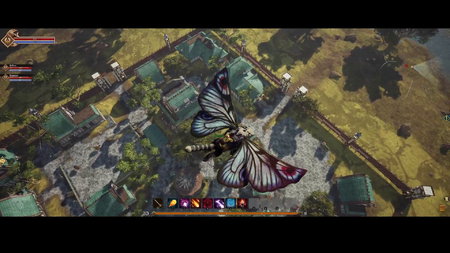
Wir haben im Wesentlichen Sets, die über alle Rassen hinweg existieren; und jede Rasse, die diese Rüstungssets trägt, wird ihren eigenen rassischen Einfluss auf die Präsentation dieser speziellen Sets haben. Das ist etwas Einzigartiges in der Art und Weise, wie jede der Rassen diversifiziert wird. Je mehr eine bestimmte Rasse zur Entwicklung einer Node beiträgt, desto mehr manifestiert sich dies in den architektonischen Einflüssen dieses bestimmten Nodes. Ihr werdet sehen, wie sich die Architekturen dieser Rassen auch innerhalb der Nodes manifestieren: Das ist eine weitere Art, wie wir jede Rasse diversifizieren und die Kultur jeder Rasse im Spiel durch diese Architekturen, durch diese existierenden Requisiten, durch die Schneiderei präsentieren der Rüstungssets, die der NPC tragen könnte, zu den verschiedenen existierenden Fraktionen. Fraktionen werden auch ihre eigene Zugehörigkeit zu verschiedenen Rassen haben. Jede Rasse wird auch eine andere Nomenklatur haben, wenn es um die Überlieferungen oder Orte in der Welt geht. Sie werden auch ihre eigenen sprachlichen Einflüsse haben: Die Art und Weise, wie sie sprechen, wird zwischen den Rassen unterschiedlich sein; wenn Sie Dialogbäume mit bestimmten NPCs haben. All diese Dinge tragen also wirklich dazu bei, eine immersive Welt zu schaffen, in der die Kulturen ihre eigene Identität haben[69] – Steven Sharif
Kulturelle Einflüsse manifestieren sich in vielerlei Hinsicht, von der Node und Ausrüstungsästhetik bis hin zu NPC languages und Überlieferungen. [69][77][1]
- Das Aussehen der Ausrüstung bestimmter Rüstungssets wird von der Rasse des Spielers beeinflusst. [69]
- Das Nodelayout und der Stil werden von der Rasse beeinflusst, die am meisten zu dieser Node beiträgt. [69]
- Vorteile können für Bürger der dominanten Kultur gelten, können aber auch für Mechaniken der Node gelten, was auch für Mitglieder andererRassen von Vorteil sein kann. [77]
- Es gibt Zermürbungsmechanismen, die Erfahrung und Einfluss beeinflussen, um eine einzelne Rasse davon abzuhalten, die ganze Welt zu dominieren. [78]
- NPCs reagieren unterschiedlich auf verschiedene Characterrassen. [79]
- Languages werden zwischen NPC Völker und in der Geschichte unterschiedlich sein. [69]
Es gibt eine Abnutzung und diese Abnutzung von Erfahrung und Einfluss wird basierend auf der Leistung des Rennens in der Welt erhöht. Wenn also all diese Nodes Ork-Nodes sind, dann ist ihre Abnutzungsrate sehr hoch, um mit der kulturellen Etablierung neuer Nodes zu konkurrieren, weil sie mehr Einfluss in der Welt haben und eine populäre Meinung gegen sie in ihren abgelegenen Regionen ist, in denen sie keinen Einfluss haben[78] – Steven Sharif
Volk-spezifische NPC Interaktionen
NPCs werden unterschiedlich auf verschiedene Tags eines Charakters reagieren.[79]
Taxation
Bürgermeister können Steuersätze für ihre Node festlegen.[80]
- Dazu gehört auch das Festlegen von Steuersätzen, die für Wirtshausspiele gelten.[81][82]
Bürgermeister/Node-Regierungen weisen Ressourcen, Steuern, und Aufträge zu , um bei der Entwicklung der Node zu helfen.[83]
- Steuergelder fließen nur in die Finanzierung der Nodeentwicklung. Dieses Gold kann nicht vom Bürgermeister oder einem anderen Spieler abgehoben werden. [24][84]
- Die Steuersätze skalieren basierend darauf, wann ein Spieler einer Node als Bürger beigetreten ist. Das Ziel ist es, finanziellen Druck auf die Node-Populationen auszuüben, indem die Steuern mit fortschreitenden Nodes, immer teurer werden, anstatt harte Bevölkerungsobergrenzen einzuführen. [85]
Übergeordnete (souveräne) Nodes erhalten einen Teil von allen Steuern aus Unterkünften und Dienstleistungen, welche von ihren Vasallen-Nodes gesammelt werden. [24][86]
- Diese Steuer wirkt sich nicht unbedingt auf den einzelnen Bürger, da die Steuersätze der Bürger von ihren Nodes bestimmt werden , aber die Finanzen der Node wird von der Besteuerung beeinflusst, die von seiner übergeordneten Node erhoben wird.[86]
Announcements and notifications
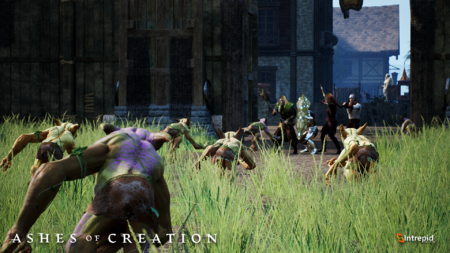
Enemies can only really grow stronger as the node grows, becoming outposts essentially for exiled or rivals of the existing order.[89] – Steven Sharif
There will be local, regional, or global (server-wide) announcements/notifications of important events.[89][90]
- Burgbelagerungen.[90]
- Node-Belagerungen.[90]
- Legendary world boss spawns.[90]
- Mob attacks and Monster coin events.[91][92][93]
- Dungeon opportunities.[93]
Event notifications will utilize different methods depending on the stage (scope and level) of the event.[89]
- Local events
- Local events (such as caravan PvP)[94][95][96] may prompt players via the UI asking if they wish to participate or not.[89]
- Other local events may offer audible or visual cues without any UI notifications.[89]
- Local events that have not been addressed may start to expand regionally or even globally.[89]
- One important thing to note about events in general is notifications are sent to the players. Players can opt into these events in a similar way that you would into a quest. You're going to be presented with a 'would you like to participate' but they might not always be that way. You might hear trees falling in the forest and that may be an audio cue to tell you something's happening over there. It's out of the ordinary. This is not normally an audio cue that I hear in this area and i'm gonna go investigate that thing. So it might not just be always that UI window represented with a 'participate or not' but I'm going to go investigate and in that sense it could be stage driven. So you might have the more local stage where it is just the visual or audio cues and you get to go participate in that stage; and then when it advances, or if you don't answer the problem in time, then it starts to expand regionally and then it might send out particular notifications to either citizens of the node from which it falls under its purview or even broader than that. It could be global driven events and then it could have things that are are visual cues that are really big like a giant blizzard that's affecting the zone, because the event hasn't been addressed; and that can affect the crop rotations or it can affect passages and roads and how caravans move. There's a lot that the predicate system informs to the event system and then the event system reacts to those types of predicates.[89] – Steven Sharif
- Node-based events
- Certain node-based events will be broadcast to node citizens,[89][93] others, such as caravans, will not be announced and will instead rely on player word-of-mouth.[90]
- Entwicklung der Node notifications will be broadcast depending on the node's stage.[97]
- New citizens of a node may be announced in a dedicated node citizen chat channel.[98]
- Election notices will be mailed to the accounts of citizens.[98]
- Whether it be like a siege or a triggered event against a city or like a unique dungeon opportunity... those types of things are going to involve notifications. Especially to the citizens of the city; where you'll be informed of an impending event. Basically it will give you time.[93] – Steven Sharif
Roads
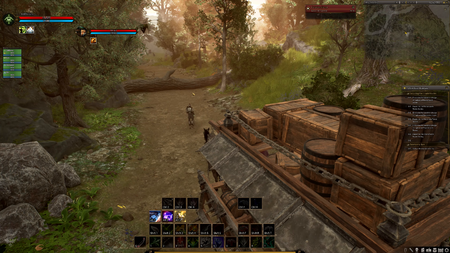
Our road system in-game is essentially driven by pre-placed routes that lead to this main artery of what was once the ancient highway system of Verra; and from there there are roads that become exposed when nodes advance; and we call those veins. They come off the main artery and then as nodes advance there are points of interest as Jeff was discussing earlier. These POIs that exist around the world and some of them share coverage with multiple nodes, but depending on which node advances to the stage that activates the point of interest it'll create these capillary roads so to speak that then stem off of the node itself. So you go from the main artery ancient road that's large- that runs through different zones and whatnot- and that breaks down into the veins that lead to the specific encampments and villages and towns that then spawn off separate capillaries that lead to the points of interest in these areas that are hunting grounds. Those are not exposed initially and they come online as players advance the world.[100] – Steven Sharif
As nodes advance, these pre-laid road spots that exist connecting every possible route between certain node structures is going to adjust and adapt, both its material presentation, the type of roadwork that's present: It'll move from dirt road type, to perhaps a brick road, to perhaps some super ornate beautiful metropolis style road that will adjust around the world according to how these node structures begin to populate and advance.[101] – Steven Sharif
Roads in Verra are both pre-generated and player influenced.[100]
- The largest roads are referred to as arteries. These are remnants of what was once the ancient highway system of Verra.[100]
- As nodes advance smaller roads, referred to as veins, connect the arteries to the nodes.[100]
- Depending on the stages of node advancement, capillary roads will stem off the node to connect to points of interest.[100]
- Roads or pathways are not worn into the landscape by repeated traffic over the same area.[100]
- The quality, safety, and maximum transportation speed of roads is influenced by node building upgrades, policies, relics, and the level of nearby nodes.[102][103][104]
- Q: Could you upgrade roads in the node to upgrade the roads and speeds of caravans?
- A: Absolutely. So that buff that you saw is a buff that can be changed in the world based on the world state. Some of those world state interactions include certain types of relics that the nodes which govern your area might have access to and might be actively employing. Some of it might have to do with policies: You might be able to extend the guard influences across the road radius further out for certain nodes if you have certain policies. You might be able to enhance and empower those guards through itemization choices that are granted by building upgrades that the node selects to build.[102] – Steven Sharif
Different seasons and events may affect access to various roads.[105][73][106][107]
- Pathways that are open during summer may be closed during winter.[105][107]
- Seasonal affects may cause obstacles or blockages to the transit of goods via caravan.[105][73][106][108]
- Caravan events can cause roadways to be blocked off or hostile mobs to spawn to attack the caravan.[99][73]
- Water turning to ice in winter, enabling players to walk over the water but blocking access to what is underneath.[107]
- Ice will make roads bumpy and slippery.[109]
Unterreich routes will open or close dynamically (based on node states).[110]
- The location of Underrealm entrances throughout the world is focused around natural geographic choke-points that exist above ground. This provides alternate subterranean routes that can be used by caravans, raids, and other player activities.[111][110]
- Not all entrances to the Underrealm will be open at the same time. This can shift dynamically (based on node states) that cause different routes to open up, which may be more or less advantageous than other routes.[110]
Komponenten für Karawanen can be utilized to improve on-road or off-road speeds of caravans.[112]
- You will travel faster over roads, but that obviously comes with the increased risk of running into other players or monsters that are blocking the road.[112] – Chris Justo
Grundbesitz may not be placed in close proximity to roads.[113]
Spielerbehausungen

Players will have the ability to survey and develop land anywhere in the world. Be a pioneer deep in the wilderness, build the home of your dreams, and work the land to cultivate resources and supplies. Alternatively, stick with civilization and safety in numbers – purchase a home within the confines of a village and watch your investment grow as that village turns into a city. Homeowners in our game will have the ability to develop their plot of land as they see fit. Focus on farming, animal husbandry, or own your very own smithy. You’ll be able to specialize your land to maximize your profits or your comfort – be sure to choose wisely.[115]
Spielerbehausungen is player-owned accommodation in the form of Apartments, Grundbesitz, Inns, and Statische Behausungen.[117][5]
A player may own up to one of each type of housing simultaneously.[118][119] Statische Behausungen and Apartments are one per server; Grundbesitz are one per account.[120]
| Spielerbehausungen | Art. | Verfügbartkeit. | Limit. |
|---|---|---|---|
| Apartments | Instanziert.[5] | Dorf Stufe und höher.[121] | Eines pro Server.[120] |
| Grundbesitz | Open World.[5] | Dorf Stufe und höher.[5] | Einer pro Account.[120] |
| Statische Behausungen | In-Node.[5] | Dorf Stufe und höher.[5] | Eine per Server.[120] |
Trophäen-Park
Trophäen-Park is an area within Stadt, Großstadt or Metropole nodes that has available spots for trophies. These trophies show the character names of players who are the first to complete world bosses and dungeon bosses that were spawned as the result of the development of that particular node.[122]
- Server announcements and achievements are designed to encourage groups to experience new content.[122]
Adaptive Inhalte
Neue Points of Interest (wie z.B. Dungeon und World Bosse) spawnen, wenn sich Nodes entwicklen.[123] Dieser Content passt sich an die Entwicklung der Zone an, in der er sich befindet.[124]
- Die Population wird sich verändern.[124]
- Die Schwierigkeit des Contents wird sich ändern.[124]
- Der Content ändert sich vielleicht Grundlegend, abhängig davon, was sich wie entwickelt.[124]
- Verschiedene Arten von Antagonisten mit verschiedenen Storylines.[124]
- Manche Dungeons werden nur freigeschaltet, wenn sich Nodes zu einer bestimmten Stufe entwickeln.[125]
- Die Ziele einer Storyline innerhalb von Dungeons hängen davon ab, welche Story Arcs durch das Node System gewählt wurden.[125]
- Drop Tables in Gebieten und Dungeons werden in die Fortschritt von bestimmten Gebieten eingebunden sein.[125]
Certain dungeons and other points of interest across the map will all be affected by the server’s node development. Some dungeons will only be unlocked if nodes are developed to certain stages. The storyline objectives for players inside dungeons will also be dependent on the story arc paths chosen through the node system. The drop tables in area and dungeons will also be tied into the progression of certain areas. For example, let’s say that the humans have developed a node in Region A, and a storyline has opened up that leads players to inspect the ruins (dungeon) of a nearby area. And let’s say that this node was developed in a scientific (crafting) zone… Well before the node developed, this dungeon was accessible… But now the dungeon has propagated new monster assets that include a drop table catering to a crafting emphasis because of the development of that academic node. And perhaps, a new boss appears in different rooms of the dungeon that includes different adventure quest starts, like a mysterious item with a storyline that can only be progressed if a node develops to the metropolis stage in a certain region, across the world. Our system is so vast, when it comes to interconnectivity and how the world reacts to the players.[125]
Corrupted areas

We just saw a corrupt zone and that zone becomes corrupt after a period of time in which players are not addressing some issues that arise through certain events or through certain story arcs; and that corruption can spread and corruption changes the spawners for resources and for monsters; and that has a fundamental effect on the resource economy of the game.[127] – Steven Sharif
Corrupted areas (zones/points of interest) can dynamically evolve with the progression of nodes and story arcs.[127][128][129][130][131][132][133]
- Vorboten that exist on Verra as dungeons are where Die Uralten are capable of pushing into the material plane. They can continue to do so under the guise of the effects of corruption as it spreads.[134]
- These are sources of NPC events that players need to address before they grow out of hand.[127][92][132]
- Players need to participate in these events to stop the spread of corruption and hold back the intrusion on the material plane.[127][134]
- If players fail to address these corrupted areas, the frequency of NPC events against their node will increase. These can lead to node buildings and services being disabled, increasing the node's vulnerability to node sieges.[135]
- It can be a very detrimental thing if corruption is not addressed; and that's the intent of corruption, is to present a challenge to the players that if not addressed it becomes exacerbated and a problem over time.[135] – Steven Sharif
- Corrupted areas do not confer corruption onto a player. Only PvP related activities lead to player corruption (in the flagging system).[136][137]
- To degree your mortal coil, as we call it, or what some might consider a soul from your character's perspective within this story- can be influenced and can be changed into a shape that's more in tune with corruption; and that's through doing PvP things you can accomplish that.[136] – Steven Sharif
- When it enters the corruption state outside of weather, in that corrupt state, you will probably see a little bit less of the influence of the season because really it's adopting that corruption, which in-and-of-itself is a season.[138] – Steven Sharif
- Corrupted areas will spawn variations of mobs and resources.[127]
- Corrupted resources are only available in corrupted areas or during certain story arcs.[127][128][139][140][141]
Siehe auch
Einzelnachweise
- ↑ 1.00 1.01 1.02 1.03 1.04 1.05 1.06 1.07 1.08 1.09 1.10 1.11 1.12 Blog - Know Your Nodes - Advance and Destroy.
- ↑ 2.0 2.1 2.2 2.3 A reactive world - Nodes.
- ↑ Video, 2017-04-20 (0:02).
- ↑

- ↑ 5.0 5.1 5.2 5.3 5.4 5.5 5.6 5.7 Node series part II – the Metropolis.
- ↑ 6.0 6.1 Liveübertragung, 2017-10-16 (50:20).
- ↑ 7.0 7.1 7.2 7.3

- ↑ 8.0 8.1 8.2 8.3 8.4

- ↑ 9.0 9.1 9.2 Interview, 2020-07-18 (10:04).
- ↑ 10.0 10.1 10.2 10.3 10.4 10.5 Interview, 2020-07-08 (1:00:15).
- ↑
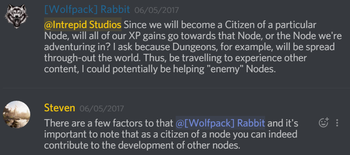
- ↑ Liveübertragung, 2021-09-24 (1:21:23).
- ↑ 13.0 13.1 Liveübertragung, 2017-05-26 (28:16).
- ↑ 14.0 14.1 14.2 14.3 14.4 Liveübertragung, 2022-10-14 (55:13).
- ↑ Liveübertragung, 2017-11-17 (55:27).
- ↑ 16.00 16.01 16.02 16.03 16.04 16.05 16.06 16.07 16.08 16.09 16.10 16.11 16.12 Blog - Know Your Nodes - The Basics.
- ↑ Liveübertragung, 2018-12-12 (14:48).
- ↑ Interview, 2020-07-20 (3:45).
- ↑ 19.0 19.1 19.2 Liveübertragung, 2022-08-26 (1:07:34).
- ↑

- ↑ Liveübertragung, 2023-08-31 (52:56).
- ↑ 22.0 22.1 Liveübertragung, 2022-08-26 (1:04:35).
- ↑

- ↑ 24.0 24.1 24.2 24.3 24.4 Liveübertragung, 2022-08-26 (1:10:16).
- ↑ Interview, 2020-07-19 (19:35).
- ↑ Liveübertragung, 2017-05-15 (30:53).
- ↑ Liveübertragung, 2022-08-26 (1:28:50).
- ↑ Interview: Ashes of Creation on Building Their Virtual World, 2017-04-13.
- ↑ 29.00 29.01 29.02 29.03 29.04 29.05 29.06 29.07 29.08 29.09 29.10 Liveübertragung, 2021-09-24 (30:26).
- ↑ Interview, 2020-07-19 (1:10:55).
- ↑ Liveübertragung, 2022-10-14 (57:22).
- ↑ 32.0 32.1 32.2 32.3 Interview, 2020-07-19 (1:08:22).
- ↑ 33.0 33.1 33.2 Liveübertragung, 2018-06-04 (39:15).
- ↑ Video, 2023-01-27 (16:44).
- ↑ 35.0 35.1 Interview, 2020-07-18 (27:11).
- ↑ Liveübertragung, 2017-05-24 (44:14).
- ↑

- ↑ Interview, 2023-09-10 (53:47).
- ↑ Liveübertragung, 2021-03-26 (1:07:33).
- ↑

- ↑ Podcast, 2017-05-05 (43:05).
- ↑

- ↑ Liveübertragung, 2017-05-03 (35:25).
- ↑ Interview, 2020-07-18 (1:00:15).
- ↑ Ashes of Creation Forums - Former Lineage 2 PvP'er wanting to discuss PvP loopholes.
- ↑ 46.0 46.1 Interview, 2020-07-19 (8:43).
- ↑ February 8, 2019 - Questions and Answers.
- ↑ Interview, 2020-07-20 (21:57).
- ↑ Liveübertragung, 2018-04-8 (PM) (55:49).
- ↑ Liveübertragung, 2020-07-25 (46:08).
- ↑ Liveübertragung, 2020-12-22 (1:15:01).
- ↑ Liveübertragung, 2022-05-27 (1:14:46).
- ↑ Video, 2022-05-27 (2:21).
- ↑ 54.0 54.1 Liveübertragung, 2024-02-29 (1:22:09).
- ↑ Podcast, 2018-08-04 (1:44:54).
- ↑ Node series part I
- ↑ 57.0 57.1 Blog: 10 facts about castle sieges in the MMORPG.
- ↑ 58.0 58.1
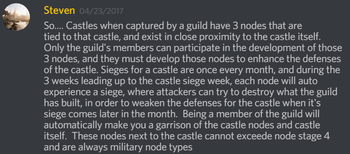
- ↑ 59.0 59.1 Podcast, 2018-04-23 (15:14).
- ↑ 60.0 60.1 Liveübertragung, 2022-08-26 (1:05:47).
- ↑ Interview, 2018-08-24 (3:44).
- ↑ Liveübertragung, 2022-08-26 (1:18:54).
- ↑ Liveübertragung, 2022-08-26 (1:06:42).
- ↑ 64.0 64.1 Liveübertragung, 2020-11-30 (37:16).
- ↑ 65.0 65.1 65.2 Liveübertragung, 2020-10-30 (39:17).
- ↑ 66.0 66.1 66.2 66.3 66.4 66.5 Liveübertragung, 2018-09-27 (53:06).
- ↑ 67.0 67.1 Liveübertragung, 2022-02-25 (41:00).
- ↑ 68.0 68.1 Liveübertragung, 2021-02-26 (1:12:18).
- ↑ 69.0 69.1 69.2 69.3 69.4 69.5 Liveübertragung, 2022-03-31 (4:57).
- ↑ Podcast, 2021-04-11 (29:47).
- ↑ Interview, 2018-05-11 (54:34).
- ↑ Liveübertragung, 2017-05-26 (21:23).
- ↑ 73.0 73.1 73.2 73.3 Podcast, 2021-04-11 (23:36).
- ↑ 74.0 74.1 Interview, 2018-05-11 (47:27).
- ↑ 75.0 75.1 Liveübertragung, 2022-07-29 (1:13:09).
- ↑ Liveübertragung, 2020-06-26 (45:32).
- ↑ 77.0 77.1 Interview, 2021-02-07 (33:00).
- ↑ 78.0 78.1 Interview, 2018-05-11 (1:00:19).
- ↑ 79.0 79.1 Podcast, 2018-04-23 (29:56).
- ↑ 80.0 80.1 Liveübertragung, 2020-03-28 (1:03:38).
- ↑

- ↑

- ↑
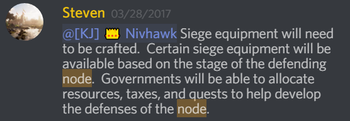
- ↑

- ↑ Interview, 2020-03-27 (0:30).
- ↑ 86.0 86.1 Interview, 2018-05-11 (57:02).
- ↑ Types of Events on Verra.
- ↑ Liveübertragung, 2022-04-29 (32:29).
- ↑ 89.0 89.1 89.2 89.3 89.4 89.5 89.6 89.7 89.8 Liveübertragung, 2022-04-29 (42:31).
- ↑ 90.0 90.1 90.2 90.3 90.4 90.5 Liveübertragung, 2018-05-04 (48:14).
- ↑ Liveübertragung, 2022-04-29 (39:00).
- ↑ 92.0 92.1 Liveübertragung, 2021-06-25 (1:13:30).
- ↑ 93.0 93.1 93.2 93.3 Interview, 2018-08-17 (24:48).
- ↑ Interview, 2020-03-27 (16:19).
- ↑

- ↑ Liveübertragung, 2017-05-22 (40:40).
- ↑ 97.0 97.1 97.2 97.3 Liveübertragung, 2021-04-30 (1:01:10).
- ↑ 98.0 98.1 Liveübertragung, 2020-10-30 (1:01:00).
- ↑ 99.0 99.1 99.2 Video, 2023-10-31 (34:12).
- ↑ 100.0 100.1 100.2 100.3 100.4 100.5 Liveübertragung, 2021-01-29 (1:13:04).
- ↑ 101.0 101.1 Liveübertragung, 2022-01-28 (33:25).
- ↑ 102.0 102.1 Liveübertragung, 2023-10-31 (1:16:34).
- ↑ Video, 2023-10-31 (28:06).
- ↑ Liveübertragung, 2018-02-09 (45:48).
- ↑ 105.0 105.1 105.2 105.3 Video, 2022-05-27 (15:50).
- ↑ 106.0 106.1 Liveübertragung, 2020-06-26 (1:29:06).
- ↑ 107.0 107.1 107.2 107.3 Liveübertragung, 2017-05-08 (20:27).
- ↑ Our immersive world - Environments.
- ↑

- ↑ 110.0 110.1 110.2 Liveübertragung, 2020-10-30 (1:19:13).
- ↑ Liveübertragung, 2022-08-26 (53:26).
- ↑ 112.0 112.1 Video, 2023-10-31 (20:17).
- ↑ Liveübertragung, 2017-05-19 (32:23).
- ↑ Video, 2017-05-25 (1:07).
- ↑ About Ashes of Creation.
- ↑ Liveübertragung, 2018-05-04 (32:46).
- ↑ Liveübertragung, 2023-08-31 (15:51).
- ↑ Interview, 2023-07-09 (42:11).
- ↑

- ↑ 120.0 120.1 120.2 120.3 Interview, 2018-05-11 (50:47).
- ↑ Steven Sharif - Clarification points from today’s stream.
- ↑ 122.0 122.1 Podcast, 2018-08-04 (1:35:58).
- ↑ Liveübertragung, 2017-11-17 (36:22).
- ↑ 124.0 124.1 124.2 124.3 124.4 Liveübertragung, 2017-11-17 (18:29).
- ↑ 125.0 125.1 125.2 125.3 MMOGames interview, January 2017
- ↑ Video, 2023-11-30 (29:26).
- ↑ 127.0 127.1 127.2 127.3 127.4 127.5 Video, 2023-11-30 (32:36).
- ↑ 128.0 128.1 Interview, 2023-07-09 (47:05).
- ↑

- ↑ Video, 2023-03-31 (1:22).
- ↑ Video, 2023-03-31 (3:32).
- ↑ 132.0 132.1 Liveübertragung, 2021-03-26 (50:03).
- ↑ Liveübertragung, 2021-03-26 (22:53).
- ↑ 134.0 134.1 Liveübertragung, 2020-11-08 (12:47).
- ↑ 135.0 135.1 Liveübertragung, 2022-01-28 (1:17:12).
- ↑ 136.0 136.1 Liveübertragung, 2023-03-31 (54:22).
- ↑ Liveübertragung, 2021-06-25 (1:32:24).
- ↑ 138.0 138.1 Liveübertragung, 2023-03-31 (58:27).
- ↑ Liveübertragung, 2023-03-31 (59:10).
- ↑ Video, 2023-03-31 (16:42).
- ↑




